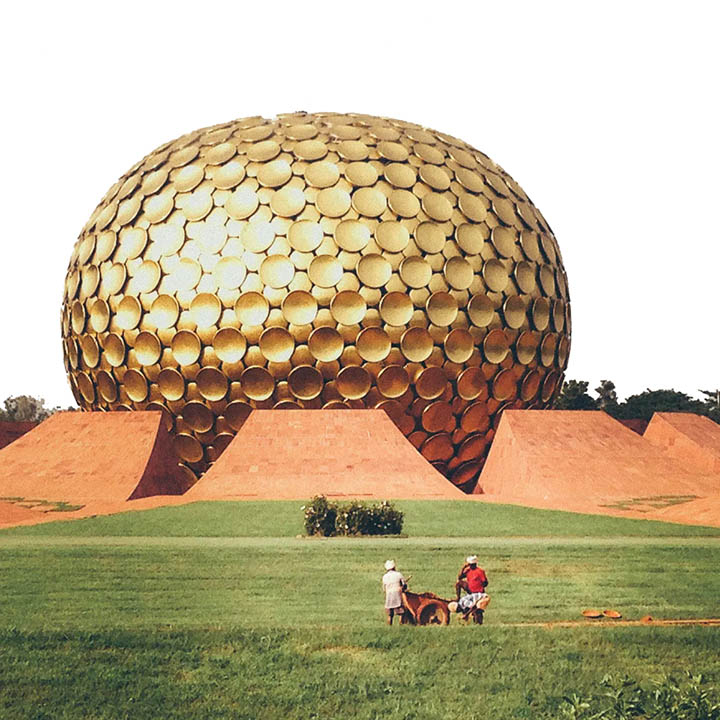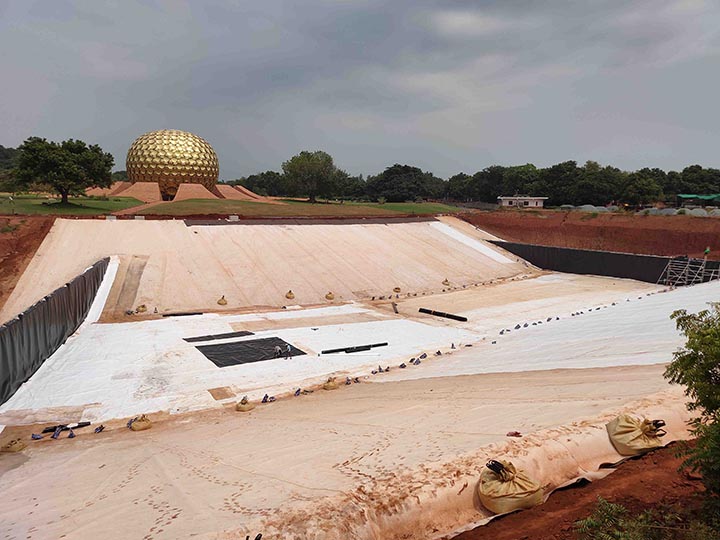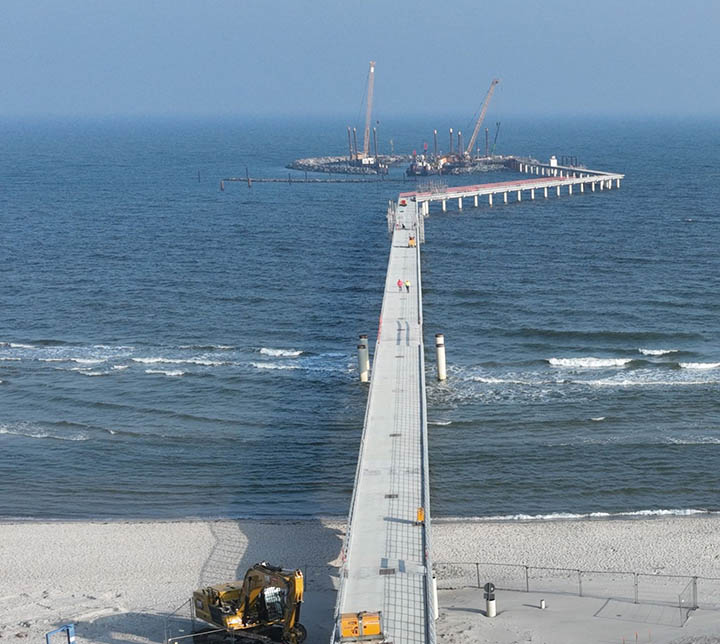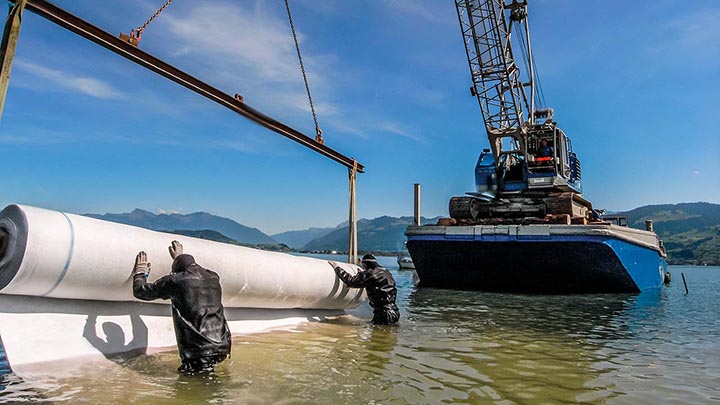A New Approach to Water Storage in the City of Dawn
When it rains in Tamil Nadu, the southernmost state of India, it certainly rains. In this monsoonal region, 90% of annual precipitation can occur in just two months, making water storage a huge challenge.
Rising to this challenge is a project currently being undertaken in the unique township of Auroville.
Outside Nations
Auroville – the City of Dawn – was founded in the optimistic hippy years of the late 1960s, following the vision of French-Indian spiritual guru, occultist and yoga teacher Mirra Alfassa to establish “a place on earth that no nation could claim as its sole property, for all humanity with no distinction.”
At the township’s opening in 1968, over 5,000 people from 124 countries gathered to listen to Alfassa – known to her followers as the Mother – outline her beliefs from The Auroville Charter.
Today, Auroville is home to over 2,600 people from over 61 countries and cash free, with residents provided with personal accounts and debit cards for transactions managed by the Auroville Foundation. All assets in the township are owned by this foundation, which, in turn, is owned by the Government of India.
Residents enjoy free electricity, healthcare, and schooling (without exams), while providing manpower and making contributions to the foundation on a monthly basis for maintenance, supplemented by income from daily visitors and longer-term guests, alongside various businesses.
Forward Thinking
Such an idealist commitment to doing things differently has not been without challenges and some controversy over the years, and the ownership of Auroville is the subject of ongoing court disputes. The venture could be open to mockery were it not for the fact that the forward-thinking residents of Auroville have also established many pioneering practices in sustainable development over the years.
In addition to producing crops consumed by the township, farmlands owned by Auroville serve as research centers for sustainable agriculture and water conservation. Buddha Garden, for example, is a farm employing a sensor-based precision irrigation system that has reduced water consumption by around 80%.
Auroville Consulting now provides advice and training to many other organizations in Tamil Nadu, especially in the areas of wind and solar energy generation. Following decades of meticulous silviculture, Auroville’s extensive forests are also among India’s most successful and have set a blueprint for further afforestation projects.
Matrimandir


At the heart of Auroville is the Matrimandir temple, an elaborate gold-plated structure that took 37 years to complete. It is called the Soul of the City and is situated in a large open space called Peace. It comprises 1,415 large gold discs and is suspended above 12 ‘petals’ – themed meditation rooms – each of which is flanked by a themed garden.
This entire area is currently being surrounded by a new artificial lake in order to further develop a water management system that will benefit the entire surrounding region. With a surface area of 170,000 square meters and a depth of ten meters, the lake is being built to store one billion liters of rainwater over ten months, ensuring water availability throughout the year.
Its construction relies on Carbofol HDPE (high-density polyethylene) geomembranes which are being supplied by Naue, based in Espelkamp, Germany. HDPE provides exceptional durability and effectiveness in preventing water seepage and the membranes have a projected lifespan of 100 years.
The lake’s shores have been carefully designed with a 1:3 slope and reinforced with large concrete blocks. The slopes are being meticulously smoothed and compacted before the HDPE waterproofing layer is installed. Once installed, the geomembrane ensures zero water loss.
Storage Cushions
In addition, the lake will contain a series of underwater fluid storage cushions made from Naue’s Carbofol, designed to store up to one million liters of drinking water, which can be filled or emptied as needed. These cushions, separated from the lake’s main water body, demonstrate flexibility and efficiency in water storage. They also offer potential applications beyond Auroville, such as freshwater storage for desalination plants.
The geomembrane’s installation is a critical process, immediately following the fine grading of the slopes to prevent damage from rain. The process involves layering a nonwoven geotextile under and over the HDPE geomembrane, topped by a 30-centimeter layer of granite chips for added protection. The meticulous engineering of the lakebed has been based on extensive soil stability and friction tests and the rainwater harvesting channel feeding the lake is also waterproofed with HDPE and connects to the lake via two pipes.
Overall, the Matrimandir Lake project is a significant leap forward in urban water management for India. Its scale, technical sophistication, and the use of Carbofol geomembranes set a new standard for sustainable water management, tailored to meet local environmental needs while integrating the latest global engineering practices.
Multi-layered needlepunched staple fiber nonwovens are filled with quartz sand as a filter and separation layer for underwater installation in hydraulic engineering.
Secutex H

In a second recent project closer to home and involving protection from water as opposed to its provision, Naue’s Secutex H sand mats are being installed around the pier of the harbor at the Baltic seaside resort of Prerow in the Western Pomerania Lagoon Area National Park in northern Germany.
These multi-layered needlepunched staple fiber nonwovens are filled with quartz sand and employed as a filter and separation layer for underwater installation in hydraulic engineering applications.
In the Prerow harbor project, they have been installed at depths of up to five meters to provide the filter layer between the seabed and breakwaters.

The positioning of the sand mats was meticulously carried out according to a detailed installation plan and the mats were delivered to the site prefabricated and numbered to further streamline the installation process.
No additional ballast layer was required during installation, saving time and costs compared to conventional constructions.
GPT Bot
In a notable development for the construction industry, Naue has introduced the Geosynthetics GPT bot which is now available on the ChatGPT Store.
The tool connects expertise in geotechnical engineering with the artificial intelligence capabilities of ChatGPT and aims to assist users in simplifying complex decisions related to the use of geosynthetic materials.
The AI-based platform efficiently and comprehensively answers questions on various topics such as erosion protection, material savings in road construction and environmental considerations in nature conservation areas.
Another important feature of the bot is its ability to evaluate different construction methods in terms of their CO2 emissions and economic costs. This will help users in the environmentally conscious and cost-effective planning of their projects.
With the introduction of Geosynthetics, Naue is demonstrating how AI technology can be effectively utilized in the planning and execution of construction projects. The company is committed to continuously improving and expanding it to meet the evolving needs of the construction industry.
Geosynthetics is available for use with ChatGPT 4.0 in the ChatGPT Store or directly from the company.


